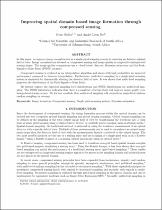JavaScript is disabled for your browser. Some features of this site may not work without it.
- ResearchSpace
- →
- Research Publications/Outputs
- →
- Conference Publications
- →
- View Item
| dc.contributor.author |
Stoltz, George G

|
|
| dc.contributor.author |
Nel, AL

|
|
| dc.date.accessioned | 2021-02-16T12:50:41Z | |
| dc.date.available | 2021-02-16T12:50:41Z | |
| dc.date.issued | 2020-10 | |
| dc.identifier.citation | Stoltz, G.G. & Nel, A. 2020. Improving spatial domain based image formation through compressed sensing. http://hdl.handle.net/10204/11773 . | en_ZA |
| dc.identifier.isbn | 9781510639140 | |
| dc.identifier.issn | 0277-786X | |
| dc.identifier.issn | 1996-756X | |
| dc.identifier.uri | http://hdl.handle.net/10204/11773 | |
| dc.description.abstract | In this paper, we improve image reconstruction in a single-pixel scanning system by selecting an detector optimal field of view. Image reconstruction is based on compressed sensing and image quality is compared to interpolated staring arrays. The image quality comparisons use a dead leaves" data set, Bayesian estimation and the Peak- Signal-to-Noise Ratio (PSNR) measure. Compressed sensing is explored as an interpolation algorithm and shows with high probability an improved performance compared to Lanczos interpolation. Furthermore, multi-level sampling in a single-pixel scanning system is simulated by dynamically altering the detector field of view. It was shown that multi-level sampling improves the distribution of the Peak-Signal-to-Noise Ratio. We further explore the expected sampling level distributions and PSNR distributions for multi-level sampling. The PSNR distribution indicates that there is a small set of levels which will improve image quality over interpolated staring arrays. We further conclude that multi-level sampling will outperform single-level uniform random sampling on average. | en_US |
| dc.format | Fulltext | en_US |
| dc.language.iso | en | en_US |
| dc.relation.uri | https://doi.org/10.1117/12.2575435 | en_US |
| dc.relation.uri | https://www.spiedigitallibrary.org/conference-proceedings-of-spie/11549.toc#FrontMatterVolume11549 | en_US |
| dc.relation.uri | https://www.spiedigitallibrary.org/conference-proceedings-of-spie/11549/115490F/Improving-spatial-domain-based-image-formation-through-compressed-sensing/10.1117/12.2575435.short | en_US |
| dc.source | Proceeding of SPIE, 11549, Advanced Optical Imaging Technologies III, September 2020 (online) | en_US |
| dc.subject | Image formation | en_US |
| dc.subject | Compressed sensing | en_US |
| dc.subject | Single pixel scanning system | en_US |
| dc.subject | Bayesian estimation | en_US |
| dc.title | Improving spatial domain based image formation through compressed sensing | en_US |
| dc.type | Conference Presentation | en_US |
| dc.description.pages | 9 | en_US |
| dc.description.note | Copyright: 2020 SPIE. Due to copyright restrictions, the attached PDF file contains the accepted version of the published item. For access to the published version, please consult the publisher's website: https://doi.org/10.1117/12.2575435 | en_US |
| dc.description.cluster | Defence and Security | |
| dc.description.impactarea | Optronic Sensor Systems | en_US |
| dc.identifier.apacitation | Stoltz, G. G., & Nel, A. (2020). Improving spatial domain based image formation through compressed sensing. http://hdl.handle.net/10204/11773 | en_ZA |
| dc.identifier.chicagocitation | Stoltz, George G, and AL Nel. "Improving spatial domain based image formation through compressed sensing." <i>Proceeding of SPIE, 11549, Advanced Optical Imaging Technologies III, September 2020 (online)</i> (2020): http://hdl.handle.net/10204/11773 | en_ZA |
| dc.identifier.vancouvercitation | Stoltz GG, Nel A, Improving spatial domain based image formation through compressed sensing; 2020. http://hdl.handle.net/10204/11773 . | en_ZA |
| dc.identifier.ris | TY - Conference Presentation AU - Stoltz, George G AU - Nel, AL AB - In this paper, we improve image reconstruction in a single-pixel scanning system by selecting an detector optimal field of view. Image reconstruction is based on compressed sensing and image quality is compared to interpolated staring arrays. The image quality comparisons use a dead leaves" data set, Bayesian estimation and the Peak- Signal-to-Noise Ratio (PSNR) measure. Compressed sensing is explored as an interpolation algorithm and shows with high probability an improved performance compared to Lanczos interpolation. Furthermore, multi-level sampling in a single-pixel scanning system is simulated by dynamically altering the detector field of view. It was shown that multi-level sampling improves the distribution of the Peak-Signal-to-Noise Ratio. We further explore the expected sampling level distributions and PSNR distributions for multi-level sampling. The PSNR distribution indicates that there is a small set of levels which will improve image quality over interpolated staring arrays. We further conclude that multi-level sampling will outperform single-level uniform random sampling on average. DA - 2020-10 DB - ResearchSpace DP - CSIR J1 - Proceeding of SPIE, 11549, Advanced Optical Imaging Technologies III, September 2020 (online) KW - Image formation KW - Compressed sensing KW - Single pixel scanning system KW - Bayesian estimation LK - https://researchspace.csir.co.za PY - 2020 SM - 9781510639140 SM - 0277-786X SM - 1996-756X T1 - Improving spatial domain based image formation through compressed sensing TI - Improving spatial domain based image formation through compressed sensing UR - http://hdl.handle.net/10204/11773 ER - | en_ZA |
| dc.identifier.worklist | 24001 | en_US |






